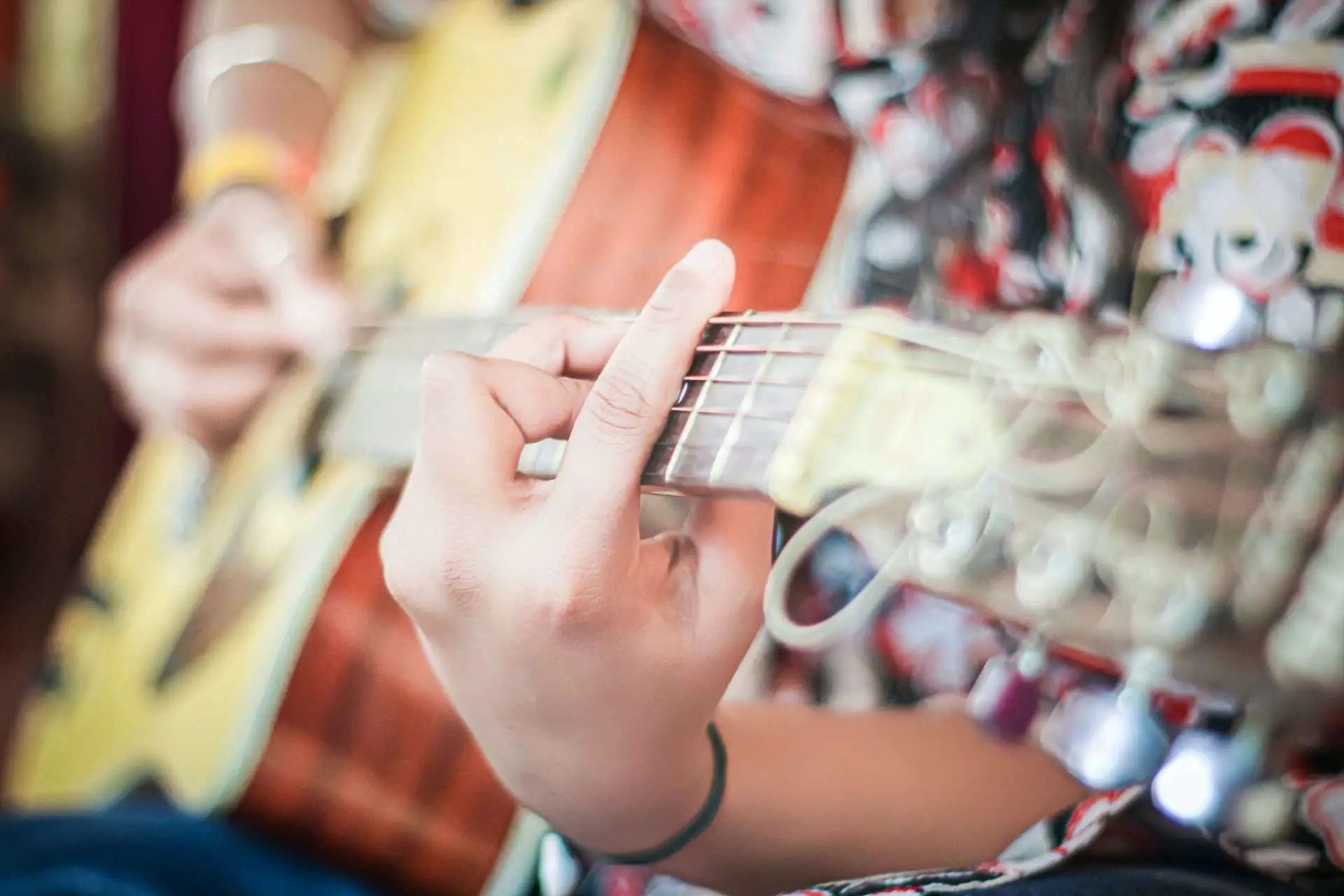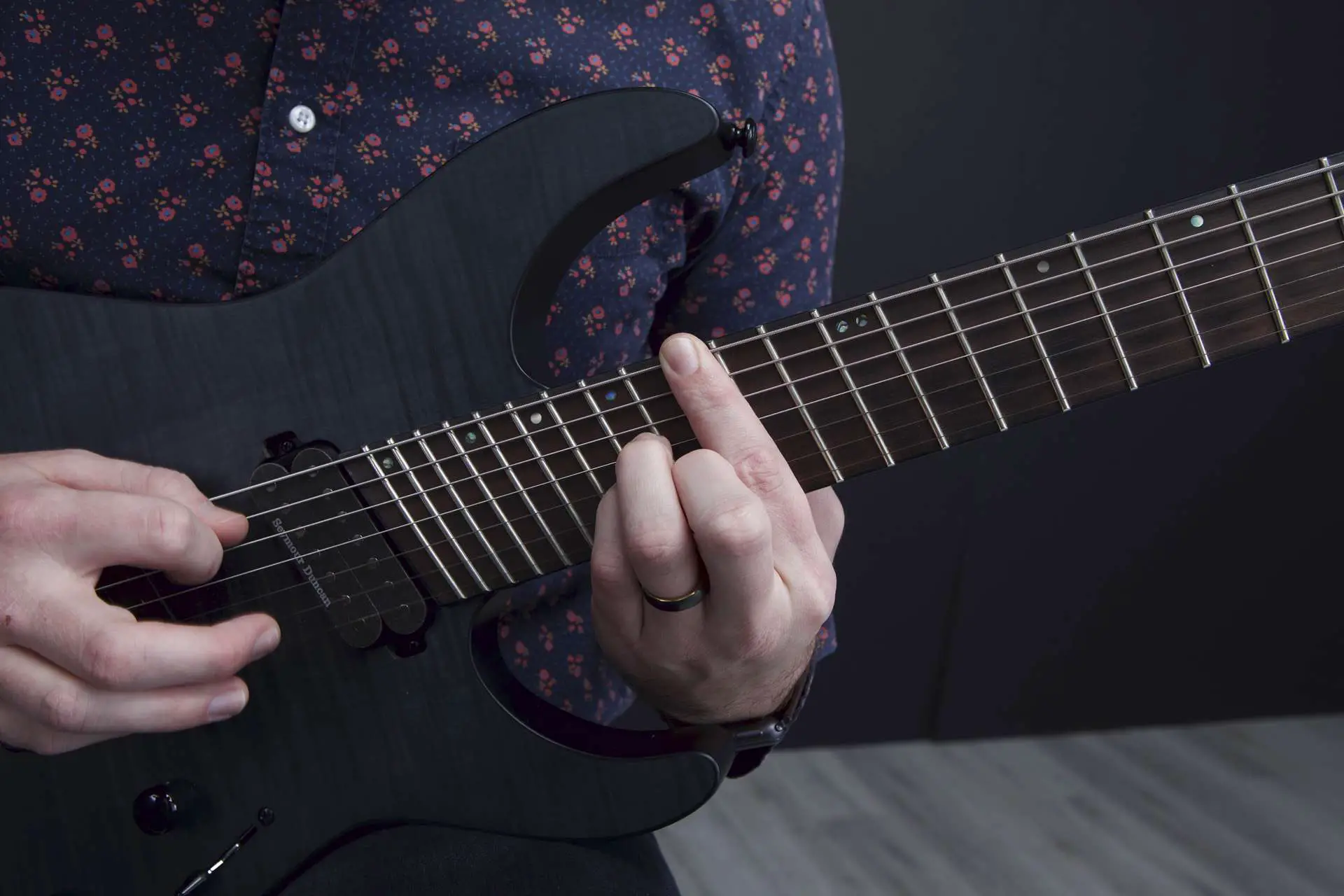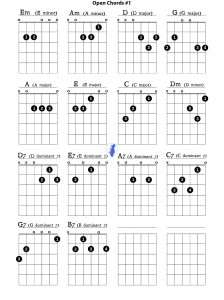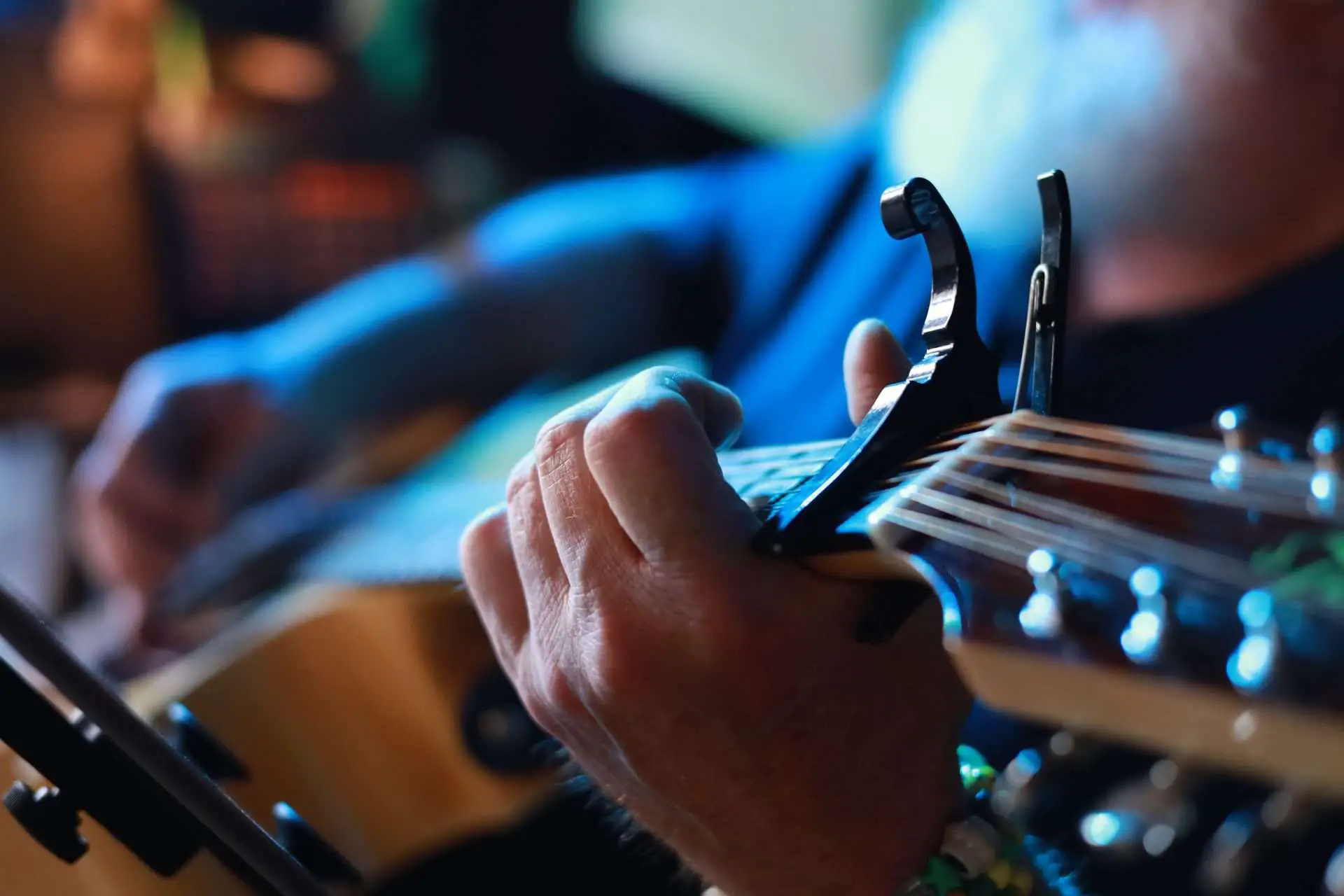Guitar chords are a fundamental building element of music and for playing guitar. They are basically made up of various complementary notes played simultaneously.
They serve as the foundation for the majority of compositions played on the guitar in some form or another.
Guitar chords not only provide the groundwork for other instruments to build upon, they also provide texture, harmony, and a sense of direction.
Ultimately they provide a fuller & more complete sound, especially when playing alone, and are a great accompaniment when playing with others.
They can be basic chords like power chords which only use 2 or 3 guitar strings, or minor chords, major chords, barre chords, open chords and so many more.
We’ll cover some basic guitar chords for beginners, how to read chord diagrams, and list all the guitar chords that we’ve covered individually so far.

What are Guitar Chords?
Guitar chords are a set of two or more notes played simultaneously on the guitar, creating a harmony or chord progression.
They provide the foundation for a melody, more complex rhythm, or vocals to be played over them in music played on the guitar.
Guitar chords are made up of at least three notes played together, typically consisting of the root note, the third, and the fifth.
As previously mentioned, guitar chords provide accompaniment, support for melody, they add depth/richness, and help establish song structure.
Guitar Chord Types
Major chord
A major chord on guitar is a chord formed by the root note, the major third, and the perfect fifth.
The major chord has a bright, upbeat tone and is frequently heard in pop, rock, and country music. Major chords are usually written with uppercase letters or symbols like the C major chord which uses “C” or “Cmaj.”
Minor chord
A minor chord is made up of the root note, the minor third, and the perfect fifth.
It has a sorrowful or melancholy sound and is typically heard in blues, rock, and metal. Minor chords are commonly represented by a lowercase letter or sign such as “Am” or “Dm.
Related: How to play the A minor pentatonic scale
Seventh chords
A seventh chord on guitar is a sort of chord that has four notes: the scale’s root, 3rd, 5th, and 7th.
Seventh chords are classified into 3 types: major 7th, dominant 7th, and minor 7th, each with its own distinct sound and function. 7th chords are popular in jazz, blues, and other genres with intricate harmonies.
Related: Learn The A 7 Minor Chords
Suspended chords
A suspended guitar chord provides tension and release. The root note, perfect fourth, and fifth notes are usually used, with the third note deleted.
Suspended chords are designated as “suspended 2” (sus2) or “suspended 4” (sus4) depending on whether the fourth or second note is employed.
Power chords
A power chord on guitar is a chord made up of either two or three notes: the root and the perfect fifth for the simplified version- or the root, fifth, and octave for the full version.
The full power chord produces a fuller & richer sound, however a two-finger power chord is easier to play, especially for novices or people with smaller hands.
Power chords can also be approached as “chord shapes” instead of having to go in-depth into technical music theory.
This makes them a great jump off point for beginner guitarists who want to play songs as soon as possible. We recommend your first few chords to be this type.
Power chords are moveable because of their “shape”, which means they may be played in various positions on the guitar neck.
This allows guitarists to play multiple chords with similar finger placements.
Power chords are essential to the electric guitar & are widely used to create basic, driving riffs and progressions in rock, punk, and metal music.
Barre chords
A “barre chord”, also known as bar chords, are a sort of guitar chord that is played by holding down multiple strings across the same fret with one finger, usually the index finger.
This results in a moveable chord shape that can be played in various positions along the neck and make sure of both bass strings & treble strings.
In acoustic guitar playing, rock, pop, and other genres, barre chords are widely utilized to play accompaniments with varied root notes without modifying the fingering.
Beginners may find the technique difficult since it requires strength and dexterity in the fretting hand to play all the notes, however they produce some of the richest sounds as you strum all the strings at once.

How to Play Guitar Chords
To play guitar chords, you need to place your fingers on the strings in a specific pattern or shape, usually indicated by chord diagrams or a chord chart.
A chord chart is a diagram that shows the guitar strings and frets that you need to hold down to form a particular chord.
The chart also shows which fingers to use & which strings to strum. By following the chord chart, you can play different guitar chords which will lead you to play songs in no time.
How to read a chord diagram
A chord diagram is a visual representation of how to play guitar chords. Here’s how to read one:
Look at the diagram to see which strings are represented. The vertical lines represent the strings, with the thickest string (E) on the left and the thinnest string (e) on the right.
Check which frets are labeled. The horizontal lines represent the frets, with the top line being the nut (where the headstock meets the fretboard). The numbers on the left side of the diagram indicate which fret to play on each string.
Observe the dots or X’s on the diagram. These represent where you need to place your fingers. The numbers inside the dots indicate which finger to use, with 1 being the index finger, 2 being the middle finger, 3 being the ring finger, and 4 being the pinky.
Pay attention to the open strings. If there is an O above a string, it means that you play that string without pressing down any frets.

Tips for fingering guitar chords correctly
First, start by placing your fingers closer behind the frets, not directly in between them.
This will help you avoid unwanted fret buzz or muting of the strings.
Second, Use the tips of your fingers to press down on the strings, not the flat part of your finger.
This will help you apply enough pressure to make the notes sound clearly.
Third, Practice each chord slowly and deliberately, making sure each note sounds clear.
Gradually increase your speed as you get more comfortable.
Fourth, Experiment with different fingerings for the same chord.
Sometimes, a different fingering may be easier or more comfortable for your hand.
Fifth, Use a metronome or drum machine to practice playing the guitar chords on beat.
This will help you develop a better sense of rhythm and timing.
Sixth, Focus on maintaining a relaxed, comfortable posture while playing.
Tension in your hands, shoulders, or neck can make it harder to play chords correctly.

Common Chord Progressions
Here are some common and popular guitar chord progressions:
I-IV-V:
This is one of the most common progressions in popular music.
It uses the I, IV, and V chords of a key, such as C, F, and G in the key of C. Examples include “Wild Thing” and “Louie Louie”.
I-V-vi-IV:
This chord progression has been used in many popular songs, such as “Let It Be” by The Beatles and “Viva La Vida” by Coldplay.
The progression uses the I, V, vi, and IV chords of a key.
ii-V-I:
This is a common jazz chord progression that uses the ii, V, and I chords of a key.
For example, in the key of C, the chords would be Dm7, G7, and Cmaj7.
vi-IV-I-V:
This is another common chord progression in pop and rock music.
It uses the vi, IV, I, and V chords of a key. Examples include “Don’t Stop Believing'” by Journey and “Sweet Child O’ Mine” by Guns N’ Roses.

Tips For Mastering Guitar Chords
Here are 8 tips for learning chords & mastering them:
Practice regularly:
Consistent practice is essential for improving your chord playing skills. Aim to practice for at least 20-30 minutes each day.
Start with the basics:
Begin with simple guitar chords like C, G, and D, and gradually work your way up to more complex guitar chords.
Use a metronome:
Practicing with a metronome can help you develop better timing and rhythm.
Practice chord transitions:
Focus on transitioning smoothly between guitar chords, starting with simple progressions and gradually increasing the difficulty.
Use proper finger placement:
Make sure your fingers are positioned correctly on the fretboard and use the tips of your fingers to press down on the strings.
Experiment with different fingerings:
Try different fingerings for the same chord to find the one that feels most comfortable and produces the best sound. Learning your inversions, or slash chords, is another great way to expand you pallet of sounds on your guitar!
Focus on accuracy, not speed:
Don’t rush through guitar chords, focus on playing them accurately and cleanly before increasing speed.
Practice strumming patterns:
Experiment with different strumming patterns to add variety and depth to your chord playing.

Common Mistakes To Avoid
Not using proper finger placement:
Make sure to use the tips of your fingers to press down on the strings and avoid muting adjacent strings.
Not practicing regularly:
Consistent practice is essential for developing your chord playing skills. Make sure to practice every day or as often as you can.
Focusing too much on speed:
Speed will come with time and practice. Instead, focus on playing each chord accurately and cleanly.
Neglecting to use a metronome:
Practicing with a metronome can help you develop better timing and rhythm, which is crucial when playing with other musicians.
Not experimenting with fingerings:
Try different fingerings for the same chord to find the one that feels most comfortable and produces the best sound.
Giving up too easily:
Learning guitar chords takes time and practice. Don’t get discouraged if you don’t get it right away. Keep practicing and you will see improvement.

Basic Guitar Chords
Here’s a few guitar chords we have covered so far. Click or tap on any of them to go in-depth on a particular chord.
Guitar Chords F#, Guitar Chords B minor, Guitar Chords B flat, Guitar Chords C #, Guitar Chords F Major 7, Guitar Chords G Major, Guitar Chords Em 7 ,5 Ways To Play The C Minor Chord On Guitar
Frequently Asked Questions
What Are The Happiest Sounding Guitar Chords?
All major guitar chords have a jovial & upbeat sound to them.
What Guitar Chords Should I Learn First?
Start with power chords since they are the easiest to play.
What Are The 3 Most Used Guitar Chords?
The guitar chords used in smoke on the water! jk
What is the hardest chord to play on guitar?
Barre chords are some of the hardest guitar chords to play because they require more strings to be held down than other guitar chords.

Learn To Play The C Maj 7 Guitar Chord
Conclusion
In this article we covered guitar chords ranging from simple chords, to more complex ones, and their associated music theory.
We also went over a bunch of tips on how to play different chords, how to read diagrams, and ultimately be able to play a clean chord & perform smooth transitions.
Hopefully you found some easy guitar chords to get you started. Remember to have patience & apply the tips. If you are still having trouble then consider a guitar teacher to help accelerate your progress.
Best of luck on your guitar playing journey!
Related: Open Guitar Chords: Made Simple
